It’s going to get easier, I think to myself, as I lie in bed in the darkness, one hand gripping tightly the edge of the mattress, the other pressing hard on the spot where my head just thudded loudly, again, into a wall. In the bunk below, my cabinmate Oleg is dozing deeply. I might not be sleeping yet, but I will once I’ve found my sea legs. I’ve come a long way, I try to reassure myself, considering it’s only my fourth night at sea.
When I arrived on board my temporary new home, Greenpeace’s MV Esperanza, even successfully navigating my way to the bathroom along the ex-Soviet firefighting ship’s labyrinth of narrow corridors had seemed impossible. The environmental NGO had invited me to join them on a month-long polar expedition departing from Patagonia, the final leg of a year-long project to draw attention to the existential threats facing the world’s oceans. The crew had set off from London, before traveling from pole to pole.
Now though, after a series of briefings, tours and tips from seasoned crew members, I know where to do laundry, where to shower, where to muster in case of emergency. I can quickly put on an immersion suit. I understand three different types of alarm. I’ve scoped out the best hiding spots for when I’ll need some privacy: the cubbyhole library; two nets on the boat’s stern where you can sit as the vast expanse of ocean stretches out behind you; and if all else fails, the floor of the linen closet. I can even use the correct maritime terms to describe the different types of wild, sudden movement the boat is making as we cross the notoriously rough Drake Passage into Antarctic waters: “pitching” up and down, or “rolling” from side to side. Still, there’s little anyone can do to help with the tiredness, nausea and bumping into an endless number of metal things that comes with the all-consuming seasickness that has long settled in.
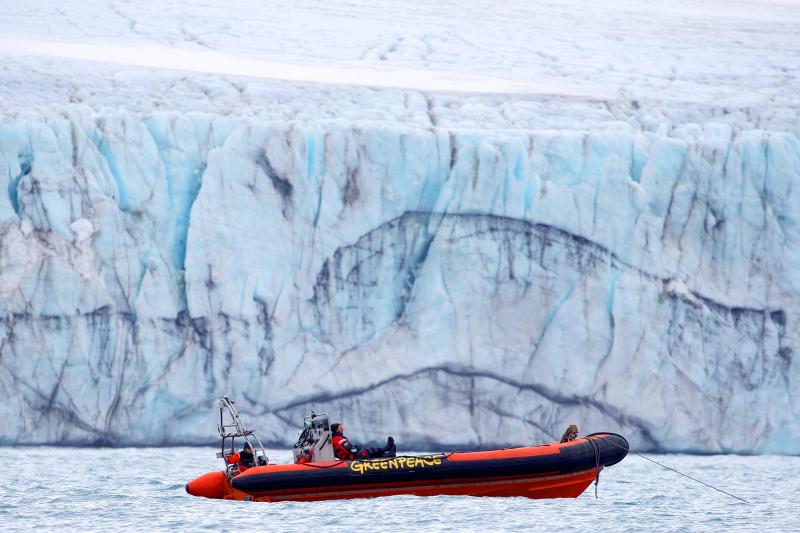
Photo: REUTERS via Greenpeace
Cruising along the Beagle Channel on our first morning — the calm, breathtaking 240km strait of water we’d sailed through after departing from Ushuaia, on the southern-most tip of Argentina — had lulled me into a false sense of security.
“It is scarcely possible to imagine anything more beautiful than the beryl-like blue of these glaciers,” Charles Darwin wrote of the strait, after an expedition here in the 1830s. He was right. Mainland Argentina on one side, Chilean islands on the other, we’d been smoothly delivered from the final frontiers of South America towards Cape Horn and out into open oceans, passing snow-capped mountains and luscious greenery - albatrosses, whales and dolphins escorting us from above and below.
MOTION SICKNESS
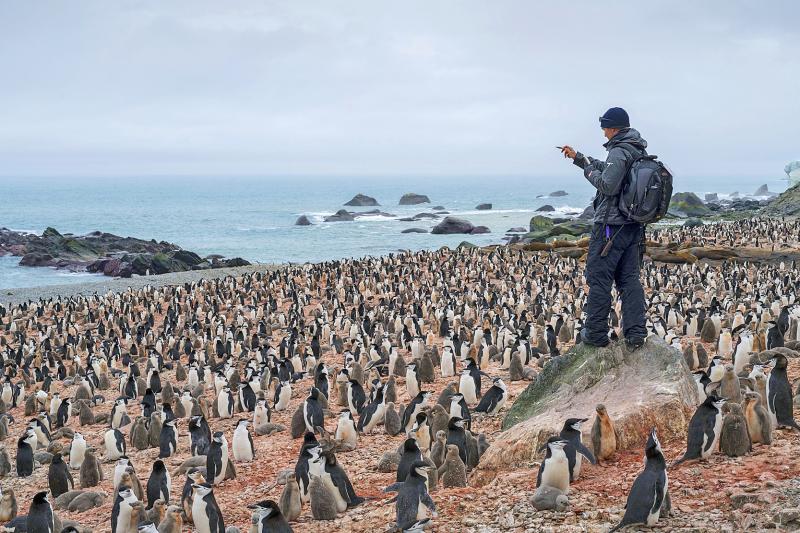
Photo: EPA-EFE via Greenpeace
I’d taken a single motion-sickness tablet as a precaution, after warnings from people who’d made the journey. Honestly? I didn’t understand the fuss. But it turns out that the Beagle’s waters are somewhat more sheltered than those of the wild and exposed Southern Ocean. Only a few days later I’m counting down the minutes until I can pop the next pill. Wave-hits-boat means head-hits-wall, again. That one was probably pitching, I mutter under my breath.
There’s sunlight creeping in through the porthole now. For days, I’ve seen nothing but water. Staring out to the horizon is the only remedy for my unrelenting unease. I clamber quietly down from my bunk and head out for the relief some much-needed fresh air might bring. Stepping out into the crisp morning, though, a surprise is waiting.
Three huge, jagged icebergs, somehow both deep blue and ghostly white in the orange light of dawn, jut out from the water right in front me, almost welcoming me into a corner of the world I imagined I’d only ever see on screen. A raft of penguins swims alongside. I’m channelling David Attenborough through my delirium. My stomach stirs with excitement — my first encounter with the Earth’s last great wilderness is all that I’d hoped for.
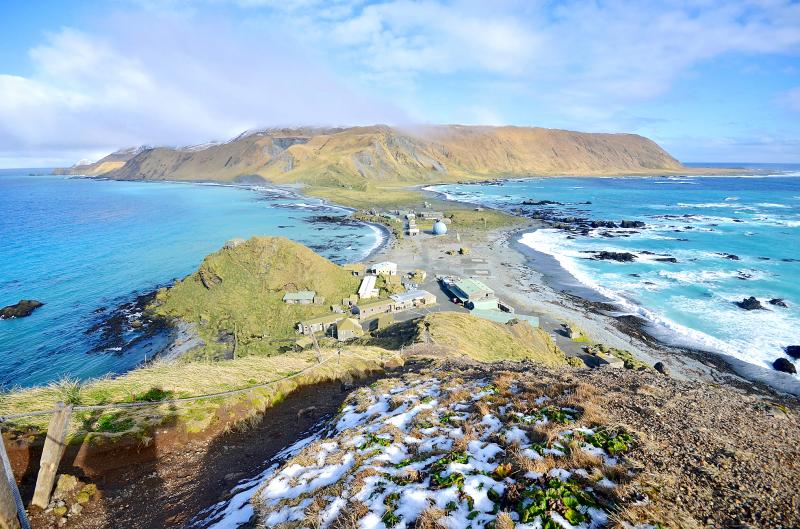
Photo: REUTERS
In the distance, the peaks of the remote South Orkney Islands are appearing. I stand transfixed, the butterflies inside growing ever more restless. And then I run to the bathroom. What I thought was awe and wonder in my gut is, in fact, a sign that I’m about to puke.
While landscapes come and go, and weather switches from blissful summer sunshine to blizzard and back again with little warning, the routine on board remains reassuringly constant. At 7:30am there’s a wake-up call while a help-yourself-breakfast wraps up in the mess. From 8am to 9am everyone pitches into the cleaning, and then the crew of 30 heads off to work. On the decks below, engineers and fitters keep us moving; from the bridge, mates navigate. A team of deckhands dutifully ensures everything is in working order, while chef Willy prepares lunch for midday. A queue forms at his hatch on the dot.
Unless you’re on watch duty, clocking off is at 5pm — just in time for an unofficial exercise class in the helicopter hangar or a smoke on the poop deck — before dinner is served up at 6pm. All the while, a small group of investigators, researchers and activists are plotting in a makeshift office. Because while the permanent crew keeps the boat running, it’s these campaigners who truly set its course.
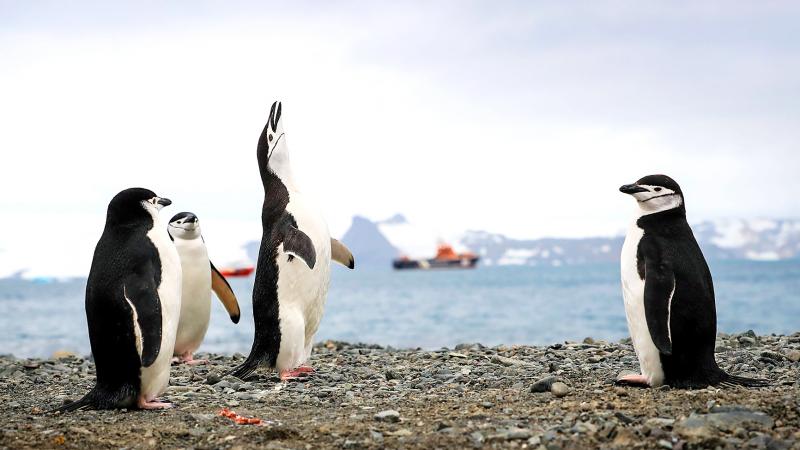
Photo: EPA-EFE
ILLEGAL ‘TRANSHIPPING’
Greenpeace employs three ships to further its environmental efforts.
Each is represented by a toy boat on a map pinned to a wall, reflecting their current positions. And as each traverses the oceans, an ever-changing team is drafted in from Greenpeace’s international offices to take the helm. From climate change to plastic pollution, deep-sea mining and oil drilling, all manner of issues have been explored on this ambitious voyage. Right now it’s an issue called “transhipping.”
After arriving in the Antarctic proper three days earlier, we’ve anchored in a sheltered bay off the South Orkneys. Glaciers lead down to the water, which is peppered with icebergs. On a distant shoreline, a smattering of structures marks the British Antarctic Survey’s Signy Island Base. The waters might have calmed, but on board the atmosphere is anything but tranquil.
Surrounded by maps, charts and laptops, Sophie Cooke, the mission’s lead investigator, is in the campaign room holding a briefing on a direct action set to take place the following morning.
Transhipping, Cooke explains, is how fishing boats transfer their catch on to cargo vessels while at sea, swapping fish for fuel, workers and supplies. It’s a system that allows fishing operations to maximize profits, simultaneously making it possible to travel into distant waters with almost no need to return to port. Earlier that day, Greenpeace had published a report that was three years in the making; it set out the harm transhipping can do, both to the oceans and the fishermen on board.
It’s how, Greenpeace argues, illegal and unregulated fish are laundered into the market, which is estimated to be worth between US$10 billion and US$23.5 billion annually. (“Dodgy fish” is mixed together in freezers with more sustainable, better regulated catch.)
Human rights abuses at sea — including poor working conditions and modern slavery — are well documented, and by transhipping, beyond scrutiny and national jurisdiction, such malpractice is too often out of sight and out of mind. There are three transhipment boats (known as reefers) currently in the South Orkneys, I’m told. Using complex satellite mapping and ship-tracking software, Cooke and her team have identified one of them — a cargo vessel they suspect has dodgy fish on board.
They plan to attach a giant rubber fender — emblazoned with the words “Ocean Destroyer” — to the ship in question, and have a group of climbers scale the side using rope ladders, to conduct a vigilante inspection in an attempt to see what’s hiding in the ship’s refrigerated hold.
VIGILANTE INSPECTION
The next morning, from a speedboat, I watch as the team pulls together with military precision. The distinction between crew and campaigner melts away.
Everyone on board has a story explaining how they ended up here. It’s not the sort of job you can stumble into. For deckhand Usnea Granger, time spent fighting to save ancient Oregon woodland from deforestation as a teenager inspired her to pursue environmental activism. Chief mate
Adrian Arauz describes the fields and rivers of his childhood in rural Panama.
“It was instilled in me from an early age that we should take care of our surroundings, because in the end it’s nature that provides,” Arauz says.
It was an oil spill off the coast of Galicia in northwestern Spain that first got a young Fernando Romo interested in marine conservation. He recalls with vivid clarity a childhood memory: walking down to the beach in his hometown to be greeted by washed-up dead wildlife, the sand drowning in crude oil. While working on a commercial tanker ship in the 1990s, he and his team were tasked with pumping oil-infused water into the sea. Soon after he became a member of Greenpeace. He was working on their ships by 2008, and promoted to the role of captain in 2017.
Compared to my digs, Romo’s cabin is practically palatial. There’s an office with room for a desk and sofa, and penguin postcards pinned to a noticeboard. A thin curtain separates his sleeping quarters from where we’re sitting.
“As captain, you’re the representative of a ship’s owner,” the 49-year-old says, “and you’re ultimately responsible for the whole operation of the ship.”
In normal circumstances, say on a cargo boat, that means getting your goods from port to port on time with no glitches. At Greenpeace, things are a little different: “We don’t deliver shipping containers, we win campaigns.”
This adds another layer of responsibility and risk to Romo’s workload. He’s not just a sailor, he’s an activist, too. It means breaking laws and putting the boat into situations that most other captains would do everything in their power to avoid.
That, Romo says, is how he stays positive. Eco-anxiety and burnout are common among environmental campaigners. I’d have imagined that spending every waking hour fighting for the planet’s future while witnessing firsthand parts of the world most vulnerable to the effects
of climate catastrophe might be hard to handle.
I don’t know why, but I arrived in the Antarctic expecting to come face to face with our shared, dystopian future. I thought that seals were going to be choking on plastic bags, that chunks of once pristine icebergs were going to be melting into piles of greyish mush. I thought it might trigger alarm bells. Instead, the air is fresher than any I’ve ever breathed, there’s wildlife in abundance, the seawater runs clear.
But being here is an eerie reminder that we can’t wait for the consequences of climate change to be visible in places like this — it will be far too late by then. It’s no coincidence, I’m realizing, that the only continent with no permanent population and few visitors is also the one in which nature has best survived the most damaging effects of humankind. And far from despairing, I feel myself becoming more determined than ever to help preserve this unsoiled natural world.
It’s suddenly real, no longer an idea in the abstract, or a scene on TV. Spending time with people who’ve given their lives to defending it is a stark reminder that most of us can, and must, play a bigger part in its survival, if we’re to turn the tide.
“If anything, I think working for Greenpeace has made me more hopeful,” Romo assures me. “You’re doing something positive and proactive, and seeing the results of your effort. Last time we came to Antarctica we were campaigning to make ocean sanctuaries to protect wildlife from overfishing. We didn’t achieve everything, but we forced the boats here into creating buffer zones for penguin feeding grounds, and that’s a win.”
Romo isn’t complacent. That’s why they’ve come back again.
“The climate emergency is the biggest threat to civilization as we know it, and that’s a challenge. But if I’m going to be anywhere to fight it, here’s the right place to be.”
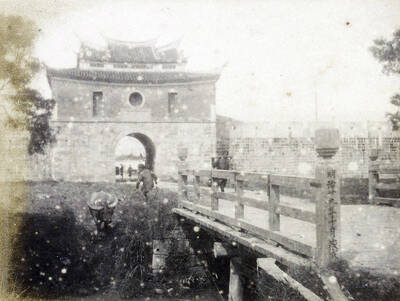
June 9 to June 15 A photo of two men riding trendy high-wheel Penny-Farthing bicycles past a Qing Dynasty gate aptly captures the essence of Taipei in 1897 — a newly colonized city on the cusp of great change. The Japanese began making significant modifications to the cityscape in 1899, tearing down Qing-era structures, widening boulevards and installing Western-style infrastructure and buildings. The photographer, Minosuke Imamura, only spent a year in Taiwan as a cartographer for the governor-general’s office, but he left behind a treasure trove of 130 images showing life at the onset of Japanese rule, spanning July 1897 to

In an interview posted online by United Daily News (UDN) on May 26, current Chinese Nationalist Party (KMT) Chairman Eric Chu (朱立倫) was asked about Taichung Mayor Lu Shiow-yen (盧秀燕) replacing him as party chair. Though not yet officially running, by the customs of Taiwan politics, Lu has been signalling she is both running for party chair and to be the party’s 2028 presidential candidate. She told an international media outlet that she was considering a run. She also gave a speech in Keelung on national priorities and foreign affairs. For details, see the May 23 edition of this column,

The Taiwan People’s Party (TPP) on May 18 held a rally in Taichung to mark the anniversary of President William Lai’s (賴清德) inauguration on May 20. The title of the rally could be loosely translated to “May 18 recall fraudulent goods” (518退貨ㄌㄨㄚˋ!). Unlike in English, where the terms are the same, “recall” (退貨) in this context refers to product recalls due to damaged, defective or fraudulent merchandise, not the political recalls (罷免) currently dominating the headlines. I attended the rally to determine if the impression was correct that the TPP under party Chairman Huang Kuo-Chang (黃國昌) had little of a

At Computex 2025, Nvidia CEO Jensen Huang (黃仁勳) urged the government to subsidize AI. “All schools in Taiwan must integrate AI into their curricula,” he declared. A few months earlier, he said, “If I were a student today, I’d immediately start using tools like ChatGPT, Gemini Pro and Grok to learn, write and accelerate my thinking.” Huang sees the AI-bullet train leaving the station. And as one of its drivers, he’s worried about youth not getting on board — bad for their careers, and bad for his workforce. As a semiconductor supply-chain powerhouse and AI hub wannabe, Taiwan is seeing